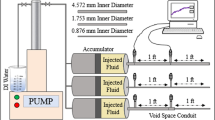Abstract
To investigate the effects of its composition and water–cement ratio on the expansion properties of a new sealing material, the factors which influence the expansion properties were identified. Subsequently, single-factor experiments were conducted to explore the effects of water–cement ratio and specific additives in a cement-based sealant on the expansion capability of the sealing material. Additionally, according to Box–Behnken experimental design principles, the rank of the important expansion factors were identified using response surface methodology. Finally, the optimal experimental conditions were obtained. The results show that the influencing factors, sorted by significance, are aluminum content (mixed with an equal amount of CaO) > water–cement ratio > gypsum content. The best mix for the sealant could be obtained with cement plus 0.56% aluminum (mixed with an equal amount of CaO) and 2% gypsum in slurry with a water–cement ratio of 0.6.
Similar content being viewed by others
References
Fan, T.; Zhou, G.; Wang, J.: Preparation and characterization of a wetting- In this section, ation-based hybrid coal dust suppressant. Process Saf. Environ. Prot. 113, 282–291 (2018)
Ni, G.; Li, Z.; Xie, H.: The mechanism and relief method of the coal seam water blocking effect (WBE) based on the surfactants. Powder Technol. 323, 60–68 (2018)
Aguilera, R.F.; Ripple, R.D.; Aguilera, R.: Link between endowments, economics and environment in conventional and unconventional gas reservoirs. Fuel 126, 224–238 (2014)
Koenders, E.A.B.; Hansen, W.; Ukrainczyk, N.; Toledo Filho, R.D.: Modeling pore continuity and durability of cementitious sealing material. J. Energy Resour. Technol. 136136(4), 042906 (2014)
Kurlenya, M.V.; Shilova, T.V.; Serdyukov, S.V.; Patutin, A.V.: Sealing of coal bed methane drainage holes by barrier screening method. J. Min. Sci. 50(4), 814–818 (2014a)
Chen, X.; Cheng, Y.: Influence of the injected water on gas outburst disasters in coal mine. Nat. Hazards 76(2), 1093–1109 (2015)
Ge, Z.; Mei, X.; Lu, Y.; Tang, J.; Xia, B.: Optimization and application of sealing material and sealing length for hydraulic fracturing borehole in underground coal mines. Arab. J. Geosci. 8(6), 3477–3490 (2015)
Zhai, C.; Xiang, X.; Zou, Q.; Yu, X.; Xu, Y.: Influence factors analysis of a flexible gel sealing material for coal-bed methane drainage boreholes. Environ. Earth Sci. 75(5), 385 (2016)
Erol, S.; Francois, B.: Efficiency of various grouting materials for borehole heat exchangers. Appl. Therm. Eng. 70(1), 788–799 (2014)
Feyzullahoğlu, E.: Abrasive wear, thermal and viscoelastic behaviors of rubber seal materials used in different working conditions. Proc. Inst. Mech. Eng. Part J: J. Eng. Tribol. 229(1), 64–73 (2014)
Kim, C.; Dixon, D.: Evaluating hydro-mechanical interactions of adjacent clay-based sealing materials. Phys. Chem. Earth 65, 98–110 (2013)
Kurlenya, M.V.; Serdyukov, S.V.; Shilova, T.V.; Patutin, A.V.: Procedure and equipment for sealing coal bed methane drainage holes by barrier shielding. J. Min. Sci. 50(5), 994–1000 (2014b)
Sahara, D.P.; Schoenball, M.; Kohl, T.; Müller, B.I.R.: Impact of fracture networks on borehole breakout heterogeneities in crystalline rock. Int. J. Rock Mech. Min. Sci. 71, 301–309 (2014)
Zhai, C.; Xiang, X.; Xu, J.; Wu, S.: The characteristics and main influencing factors affecting coal and gas outbursts in Chinese Pingdingshan mining region. Nat. Hazards 82(1), 507–530 (2016)
Jawed, I.; Skalny, J.: Alkalies in cement: a review: II. Effects of alkalies on hydration and performance of Portland cement. Cem. Concr. Res. 8(1), 37–51 (1978)
Zhai, C.; Hao, Z.; Lin, B.: Research on a new composite sealing material of gas drainage borehole and its sealing performance. Procedia Eng. 26, 1406–1416 (2011)
Cheng, Z.; Xu, Y.; Guanhua, N.; Min, L.; Zhiyong, H.: Microscopic properties and sealing performance of new gas drainage drilling sealing material. Int. J. Min. Sci. Technol. 23(4), 475–480 (2013)
Zhai, C.; Xu, J.; Xiang, X.; Zhong, C.: Flexible gel (FG) for gas-drainage drilling sealing material based on orthogonal design. Int. J. Min. Sci. Technol. 25(6), 1031–1036 (2015)
Guo, R.; Dixon, D.: Thermohydromechanical simulations of the natural cooling stage of the tunnel sealing experiment. Eng. Geol. 85(3–4), 313–331 (2006)
Akgün, H.: Geotechnical characterization and performance assessment of bentonite/sand mixtures for underground waste repository sealing. Appl. Clay Sci. 49(4), 0–399 (2010)
Pusch, R.: A technique to delay hydration and maturation of borehole seals of expansive clay. Eng. Geol. 121(1–2), 1–6 (2011)
Zou, Q.; Baiquan, L.; Chunshan, Z.: Novel integrated techniques of drilling–slotting–separation-sealing for enhanced coal bed methane recovery in underground coal mines. J. Nat. Gas Sci. Eng. 26, 960–973 (2015)
Zhou, Z.; Zeng, M.: Comparison and analysis of testing methods for plastic swelling rate of cement based grouting materials. New Build. Mater. 38, 59–60 (2011)
Xuan, W.; Wang, T.: Effect of delayed expansion agent on properties of cement-based sealing materials. J. Saf. Sci. Technol. 11(6), 115–119 (2015)
Fu, Q.; Keren, Z.; You, J.; Xiling, Z.; Fengliang, C.: Effect of content of aluminum powder on pore morphology of cement and emulsified-asphalt binders. J. Chin. Ceram. Soc. 42(10), 1260–1265(6) (2014)
Wang, Z.; Chen, X.; You, B.: Expansion and application principle of static crushing agent. Expans. Agents Expans. Concr. 9(4), 3–4 (2017)
Acknowledgements
Financial support for this work was provided by the National Natural Science Foundation of China (Nos. 51504189 and 51874233). We thank David Frishman, Ph.D., from Liwen Bianji, Edanz Group China (www.liwenbianji.cn/ac), for editing the English text of a draft of this manuscript.
Author information
Authors and Affiliations
Corresponding author
Rights and permissions
About this article
Cite this article
Zhang, C., Liu, H., Li, S. et al. Experimental Study on the Expansion of a New Cement-Based Borehole Sealing Material Using Different Additives and Varied Water–Cement Ratios. Arab J Sci Eng 44, 8717–8725 (2019). https://doi.org/10.1007/s13369-019-03837-3
Received:
Accepted:
Published:
Issue Date:
DOI: https://doi.org/10.1007/s13369-019-03837-3




